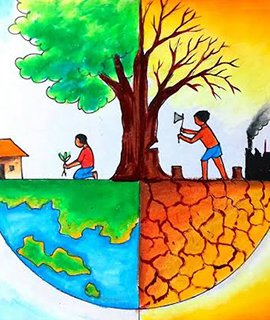World of Change Global Temperatures

The planet is becoming increasingly hot. Whether the cause is human activity or natural variability—and the overwhelming evidence points to humans—thermometer readings have climbed gradually all around the world since the Industrial Revolution began. (To advance through the decades, click on the bullets above.)
According to scientists at NASA's Goddard Institute for Space Studies (GISS), the average global temperature on Earth has grown by around 0.8 degrees Celsius (1.4 degrees Fahrenheit) since 1880. Since 1975, two-thirds of the warming has occurred, at a pace of about 0.15-0.20°C each decade.
But why should we be concerned about a single degree of global warming? After all, where we live, the temperature varies by several degrees every day.
The global temperature record is an average of the planet's whole surface temperature. Because of predictable cyclical occurrences (night and day, summer and winter) and difficult-to-predict wind and precipitation patterns, the temperatures we experience locally and over short periods of time can vary dramatically. However, the global temperature is mostly determined by how much energy the earth receives from the Sun and how much it radiates back into space—both of which are relatively constant amounts. The chemical composition of the atmosphere, particularly the amount of heat-trapping greenhouse gases, has a substantial impact on the amount of energy emitted by the Earth.
A one-degree change in global temperature is noteworthy since it takes a lot of heat to warm all of the oceans, atmosphere, and land by that much. A one- to two-degree decrease was all it needed to send the Earth into the Little Ice Age in the past. 20,000 years ago, a five-degree reduction in temperature was enough to bury a major portion of North America beneath a massive mass of ice.
The maps above show temperature anomalies, or changes, not absolute temperature. They depict how much various regions of the world have warmed or cooled when compared with a base period of 1951-1980. (The global mean surface air temperature for that period was estimated to be 14°C (57°F), with an uncertainty of several tenths of a degree.) In other words, the maps show how much warmer or colder a region is compared to the norm for that region from 1951-1980.
Global temperature records start around 1880 because observations did not sufficiently cover enough of the planet prior to that time. The period of 1951-1980 was chosen largely because the U.S. National Weather Service uses a three-decade period to define “normal” or average temperature. The GISS temperature analysis effort began around 1980, so the most recent 30 years was 1951-1980. It is also a period when many of today’s adults grew up, so it is a common reference that many people can remember.
The line plot below shows yearly temperature anomalies from 1880 to 2014 as recorded by NASA, NOAA, the Japan Meteorological Agency, and the Met Office Hadley Centre (United Kingdom). Though there are minor variations from year to year, all four records show peaks and valleys in sync with each other. All show rapid warming in the past few decades, and all show the last decade as the warmest.








Leave A Comment